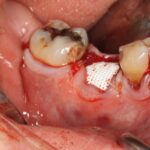
Tooth extraction is a very common procedure and subsequently the supporting alveolar ridge remodels. Most of this remodelling of the alveolar bone take place in the first 3 months with a reported average reduction in height of 1.24mm and 3.8mm in width. Changes in the alveolar ridge following tooth extraction may compromise rehabilitation with dental implants or prosthesis. Consequently, a number of different procedures have been used to preserve or maintain the alveolar ridge.
The aim of this Cochrane review update was to assess the effectiveness of techniques for alveolar ridge preservation (ARP) following dental extractions prior to implant placement.
Methods
Searches were conducted in the Cochrane Oral Health’s Trials Register, the Cochrane Central Register of Controlled Trials (CENTRAL), Medline, Embase Ovid, Latin American and Caribbean Health Science Information database, Web of Science Conference Proceedings, Scopus, ProQuest Dissertations and Theses, OpenGrey, the US National Institutes of Health Ongoing Trials Register (ClinicalTrials.gov) and the World Health Organization International Clinical Trials Registry Platform databases with no restrictions on date or language.
Randomised controlled trials (RCTs) of ARP techniques with at least six months of follow-up were considered. Outcomes included changes in width and height of the alveolar ridge, complications, the need for additional intervention prior to implant placement. Three reviewers screened and selected studies, extracted data and assessed risk of bias following Cochrane methods. Mean difference (MD) and 95% confidence interval (CI) were calculated for continuous outcomes such as changes in width and height of alveolar ridge and risk ratios (RR) and 95%CIs for dichotomous outcomes such as implant failure rate. GRADE was used to assess the certainty of the evidence.
Results
- 16 RCTs involving 426 adults and 524 extraction sites were included.
- 4 trials were considered to be at high risk of bias and 12 at unclear risk.
ARP versus extraction
- 7 RCTs compared xenografts with extraction alone there is very low-certainty evidence of a reduction in loss of alveolar ridge width and height in favour of xenografts: –
- Width MD = -1.18 mm (95%CI; -1.82 to -0.54) [6 RCTs, 184 patients, 201 extraction sites]
- Height MD = -1.35 mm (95%CI; -2.00 to -0.70) [6 RCTs, 184 patients, 201 extraction sites].
- There was no evidence of a significant difference for the need for additional augmentation or in implant failure rate: –
- Additional augmentation RR= 0.68 (95%CI; 0.29 to 1.62) [ 4 RCTs, 154 patients, 156 extraction sites; very low-certainty evidence].
- Implant failure rate RR = 1.00 (95%CI0.07 to 14.90) [2 RCTs, 70 patients/extraction sites; very low-certainty evidence].
- One RCT trial (15 patients, 60 extraction sites) compared alloplasts with extraction, providing very low- certainty evidence of a reduction in loss of alveolar ridge height in favour of alloplasts.
- MD = -3.73 mm (95%CI; -4.05 to -3.41).
Different grafting materials for ARP
- 3 RCTs (87 patients/extraction sites) compared allograft versus xenograft,
- 2 RCTs (37 patients, 55 extraction sites) compared alloplast versus xenograft,
- One trial (20 patients /extraction sites) compared alloplast with and without membrane,
- One trial (18 patients, 36 extraction sites) compared allograft with and without synthetic cell-binding peptide P-15,
- One trial (30 patients /extraction sites) compared alloplast with different particle sizes.
- The evidence was of very low certainty for most comparisons and insufficient to determine whether there are clinically significant differences between different ARP techniques based on changes in alveolar ridge width and height, the need for additional augmentation prior to implant placement, or implant failure.
- No trials were found which evaluated parameters relating to clinical attachment levels, specific aesthetic or prosthodontic outcomes for any of the comparisons.
- No serious adverse events were reported
Conclusions
The authors concluded: –
ARP techniques may minimise the overall changes in residual ridge height and width six months after extraction, but the evidence is very uncertain. There is lack of evidence of any differences in the need for additional augmentation at the time of implant placement, implant failure, aesthetic outcomes, or any other clinical parameters due to lack of information or long-term data. There is no evidence of any clinically significant difference between different grafting materials and barriers used for ARP. Further long-term RCTs that follow CONSORT guidelines are necessary.
Comments
This Cochrane review updates the 2015 review (Dental Elf – 2nd Jun 2015) adding 9 new RCTs. None of the included studies are at low risk of bias with the available evidence only providing very low certainty that alveolar ridge preservation techniques may minimise the loss of ridge width and height under ideal circumstances. The authors highlight 16 other reviews of this topic which have been published since 2011 and while these are of variable quality, they all suggest that ARP may improve bone dimensions. However, the quality of the evidence remains of low certainty and well conducted and reported longer -term studies are needed to improve the certainty of the findings.
Links
Primary Paper
Atieh MA, Alsabeeha NHM, Payne AGT, Ali S, Faggion CM Jr, Esposito M. Interventions for replacing missing teeth: alveolar ridge preservation techniques for dental implant site development. Cochrane Database of Systematic Reviews 2021, Issue 4. Art. No.: CD010176.
DOI: 10.1002/14651858.CD010176.pub3.
Other references
Cochrane Oral Health Blog – What works best to preserve the jaw bone after tooth extraction?
Dental Elf – 2nd Jun 2015
Alveolar ridge preservation: limited evidence for current techniques
Dental Elf – 22nd Jan 2020
Picture Credits
By Ian Furst – Own work, CC BY-SA 4.0.
